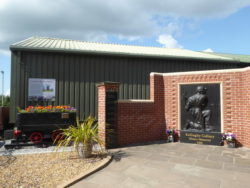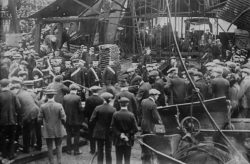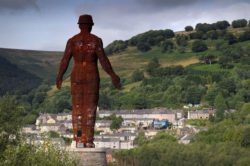Death Underground: Memories of Mining Accidents
A guest blog by David Selway (Cardiff University)
David gave a talk on his research as part of the events programme associated with our 'Remembrance' exhibition at Abbey House Museum. Listen to the talk here and read more about his research below.
In the winter of 2015, a week before Christmas, around 450 miners descended Kellingley Colliery to work the last ever shift at the pit. With its closure, came the end of deep coal mining in Britain, and, effectively, the death of an industry that had, at one time, employed over 1.2 million people. Though appearing to pass largely unnoticed within the UK, the ripples from this momentous occasion were felt far beyond North Yorkshire. In the United States, the New York Times reported on the decline of a totemic industry, one which had fuelled the industrial revolution, and carried Britain through two World Wars. It also noted how the Kellingley miners – as they entered the colliery for the final time – would pass by a sculpture commemorating the seventeen men who had lost their lives there since the mine had opened in 1965, and reflected on the risks inherent in one of the most dangerous of industries.

The Kellingley memorial, originally at the colliery and moved to the National Coal Mining Museum when the pit shut.
There has always been a close association between death and coal mining in the public imagination – though one that has focused primarily on big pit disasters. Large explosions underground, such as those at Gresford (1934), Senghennydd (1913), or the Oaks Colliery in Barnsley (1866), would draw to the coalfields a level of press attention matched by only the greatest of national strikes, and they have dominated representations of miners and their communities in popular culture. A recurring theme in novels – from Emile Zola’s Germinal to A.J. Cronin’s The Stars Look Down – they have also featured prominently in films set within the coalfields. Indeed, such is this prominence, that historian Bert Hogenkemp has claimed that ‘a mining film without a disaster is like a Western without a shoot-out.’ For many people pit disasters have been almost synonymous with the mining communities that they so often devastated.

The Senghenydd Colliery disaster in 1913.
When I began my doctoral research on collective memory in the South Wales coalfield, I had imagined that such tragedies would be similarly prominent within people’s memories of the industry. Yet, when listening to oral history interviews that had been recorded in the 1970s, pit disasters were only rarely discussed. It was not that the miners and their families did not talk about the dangers of the pit – indeed, most spoke movingly of the deaths of family, friends and work-mates. Rather, it was that the big disasters which seized the attention of reporters and newspapermen, dominated headlines, and provided such a dramatic setting for so many novelists and filmmakers, were only ever a small part of the mining communities’ experience of death underground. Overwhelmingly, miners were killed in ones and twos in small-scale incidents – roof-falls, haulage accidents, small explosions – largely unreported and seemingly unnoticed by those outside the coalfields.

The memorial commemorating the Six Bells mining disaster at Abertillery, Wales, in 1960.
The nature of this experience understandably led to considerable resentment at how those dangers were reported (or ignored) by the national press. But it also led to a distinctive way of thinking about the dangers of the industry, and of remembering those whose lives it had taken. For those within the coalfields, death was ever-present – a part of those communities’ present and future as much as their pasts. At Kellingley, the miners had tragically had to add another name to their memorial only months after it had been unveiled, when one of their friends and work-mates had been killed by a roof-fall. It was only with the closures of the collieries that this relationship between coal-mining and death was ended, and this distinctive way of thinking about and remembering such tragedies began to change.
You can read more about David's research in his article which won the 2016 Labour History Review Essay Prize, 'Death Underground: Mining Accidents and Memory in South Wales, 1913–74'.
